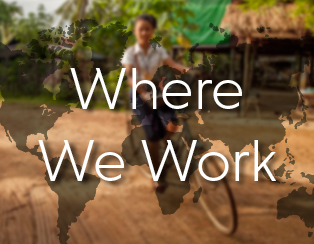Transforming towns together
By Jillian SlutzkerJuly 25, 2018
Inside the collective strategy to prevent violence in El Salvador
Alexis de la O Romero, 15, shakes hands with his teacher and bumps fists with a friend before sliding into a desk at school and pulling his notebook and pencils from his backpack. He hands in homework and is attentive to the lesson. But not so long ago, he’ll tell you, he was a different person.
“I was always on the streets. I wouldn’t listen to my family. I wouldn’t go to class,” he says.
In Cojutepeque, a city as renowned for its crime rates as for its world-famous chorizo, these behaviors can be an indicator of risk for engaging with the local ecosystem of gangs and violence. Concerned Alexis would fall into the same pattern as so many other youth in Cojutepeque, a teacher referred him to a family counseling program, part of the El Salvador Crime and Violence Prevention Project.
The project, which is funded by USAID and implemented by Creative, evaluated Alexis – and 1,040 other youth – on his level of risk using a method known as the Youth Service Eligibility Tool. The tool assesses youth risk across individual, peer and family level domains using a series of nine risk factors—such as a critical life events, substance abuse and negative peer influence.
Of the more than 1,000 youth the project assessed in that cycle, 142, including Alexis, displayed factors placing them at high risk for violence, referred to as secondary level risk. Of that group, 105 opted into the secondary violence prevention program.
Over the course of 18 months, Alexis and his family worked in close partnership with a trained family counselor to address problem-solving, change negative family dynamics and lower risk factors for joining a violent group. After just the first six months, 92 percent of those 105 youth, including Alexis, no longer demonstrated four or more risk factors, placing them below the threshold of risk for violent behavior or joining gangs—a service to the youth, their families and communities.
“It’s a lot of help, both for them [the youth] and for us parents and, in addition, for the family environment and even with neighbors,” says Alexis’s father, Víctor Manuel Marroquín.
He says he and his son’s relationship changed as they worked together to address issues within the family and those his son confronted. Alexis became more open with his family, and his behavior outside the home improved too.
“I was always getting into fights. I would disrespect professors,” says Alexis of his past. “But the program helped me understand that that wasn’t going to get me anywhere. Well, I thought about it and I started going to class. I would pay more attention to my teachers. I would no longer disrespect them. I calmed down.”
As he thinks about the possibilities for his future, he is grateful to have been given the tools and opportunity to change.
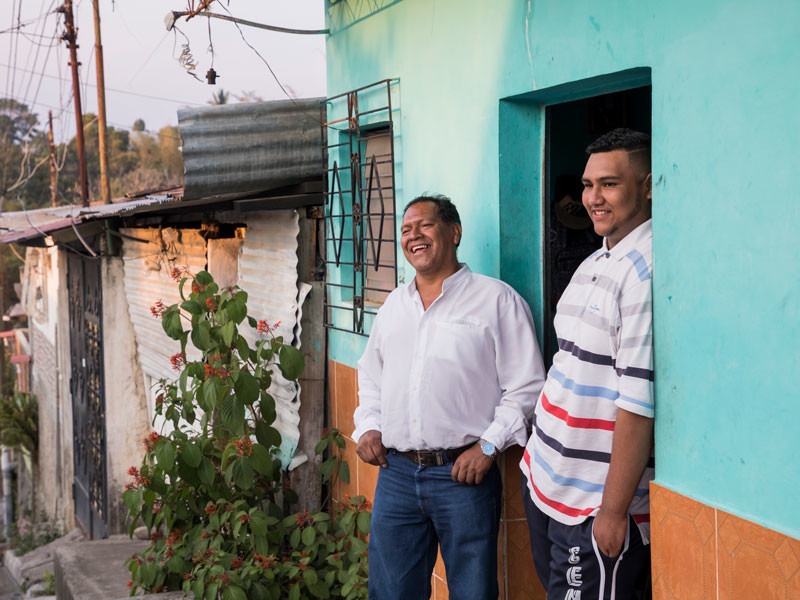
“If I hadn’t joined the program, I don’t know where I would be right now,” he says.
But imagining where he may go and what he may achieve is becoming easier as his community also undergoes a transformation—through the recovery of public spaces, crime data collection that makes streets more secure, skills and jobs for youth, and innovative measures to reach youth just like him.
Diagnosing the problem, focusing on the hot spots
As youth like Alexis work within their own homes to build resiliency to violence, communities like Cojutepeque are taking action in the streets, informed by improved access to crime data.
Pulling information on crime from a range of actors like police, hospitals and schools, the Cojutepeque Municipal Crime and Violence Observatory discerns patterns in violent activity that can and have helped the municipality take practical steps so families can venture out, kids can walk to school and vendors can sell their goods in more secure environments. With details about types of crime, weapons used, time, location and more, the municipalities have implemented measures including posting more police in locations where theft is more likely or installing lighting to illuminate streets.
The observatory is one critical piece of a multi-part effort in Cojutepeque and 54 other high- and medium-risk municipalities, from bustling San Salvador to coastal Conchagua, to bring all hands and resources on deck to reduce crime and violence and expand opportunity for residents.
Two tandem philosophies guide these efforts of the Crime and Violence Prevention Project to create what is known as a place-based, public health approach.
Viewing violence as a public health risk much like a disease, the project uses data to define and diagnose the problem, identify and evaluate levels of risk for violent behavior, implement treatment or interventions and evaluate the results. To interrupt the spread of violence, the project focuses on youth at three levels of risk – the general population living in a dangerous area, those most at risk for participating in violence, like Alexis, and juvenile offenders on the path to rehabilitation and reintegration.
And by targeting strategic hotspots of violence like Cojutepeque, the project can more effectively reduce violence nationwide starting at the local level. It brings together citizens, national government and city officials, police, youth, the private sector and the media.
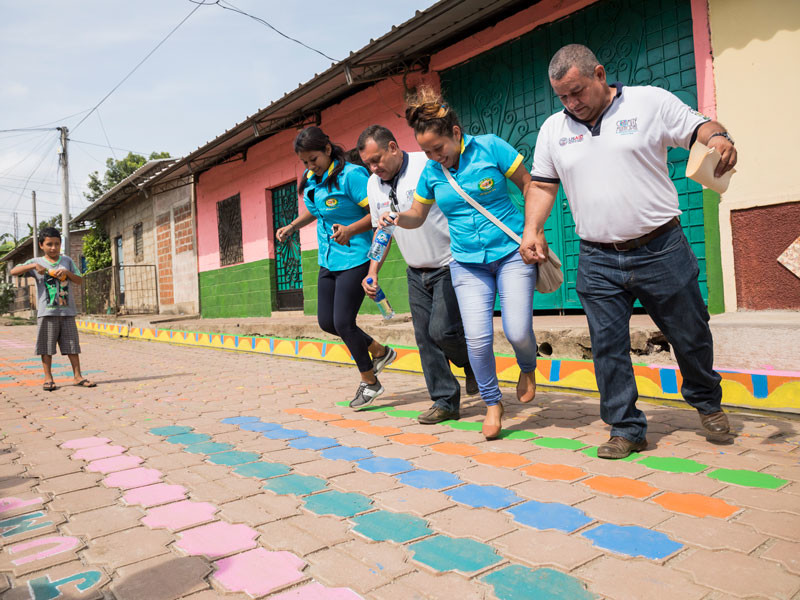
“Severe gang-related violence deeply marks everyday life in semi-rural Cojutepeque,” says Javier Calvo, Chief of Party for the project. “To address violence more effectively, we believe that our efforts must be rooted in a multilevel and evidence-based strategy that promotes bottom-up community engagement, where the general public can work together with the police, local leaders and other stakeholders to collectively develop strategies to lower risk factors and increase resilience and social cohesion.”
Based on a municipality’s needs, the project supports local leaders to deploy a combination of its more than 40 prevention tools as part of six interactive strategies that address everything from a lack of jobs to limited local capacity to track and prevent crime.
Now in its sixth year, more than 98,600 Salvadorans have participated in project initiatives, including 1,444 young musicians playing in neighborhood philharmonics instead of spending idle time on the streets; more than 29,200 youth beneficiaries and 1,700 volunteers keeping neighborhood Outreach Centers buzzing; and 1,558 members of Municipal Crime and Violence Prevention Committees leading community security initiatives.
Safe spaces that help transform communities
On any given day, in Cojutepeque and municipalities across the country, 166 neighborhood Outreach Centers are bustling. Kids, teens and young adults play pick-up soccer games, practice their English skills, take life skills courses, rehearse routines with their dance clubs or just hang out. Some 32,000 youth attend these centers nationwide.
What’s remarkable about these scenes? In many cases, before the arrival of the Outreach Center, or Centro de Alcance in Spanish, youth in these neighborhoods lacked a secure place to play, socialize after school and spend their time productively. The alternative is the streets, where futures are uncertain and violence is always a risk.
As part of their participation in the centers, youth chart their dreams and goals for life and map out pathways to reach them, troubleshooting with mentors to overcome obstacles along the way. Neighborhood volunteers, often young people themselves, keep the center’s activities alive.
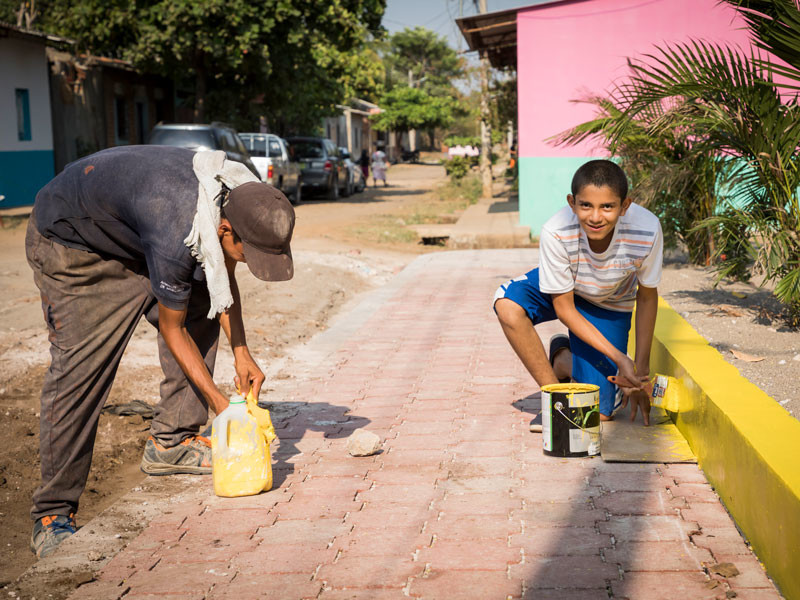
These Outreach Center volunteers are also key to project-supported and municipality-led public space recovery projects that have turned abandoned lots into soccer fields and desolate streets into colorful avenues for community markets and celebrations. To date, communities nationwide have inaugurated 64 such projects, and an additional 41 are in the works in eight municipalities.
Magdalena Magaña, who leads the project’s public space recovery initiatives across the country, says this large number of projects is a culmination of citywide collaborations.
“In the end, we all work to create and generate the conditions and spaces for healthy recreation and to generate smiles in each of the kids of the community,” she says.
She tells volunteers that although these projects take hard work, they are worth it so the community’s youth, families and residents can reclaim part of their city and take pride in what they have built together.
A skill, paycheck and path forward
Meanwhile, as kids and youth spend free time at Outreach Centers and newly opened public parks, the project also helps to expand economic opportunity for young adults in these hard-hit areas.
Jorge Jonathan Mendoza Ramos, 28, is one of them.
On his first day of air conditioning repair class, he examines unknown tools, tubes and fluids that he will study and manipulate over the next several weeks. Unemployed and eager to start a business with friends, Mendoza enrolled in this course at Cojutepeque’s Municipal Vocational Training Center, known by its Spanish acronym FORMATE.
Though only his first day, Mendoza is itching to get to work and master the skills that will help shape his future.
“We already have a lot of knowledge. We’ve started to learn the new tools and different types of air conditioners,” he says. “I think that a year from now, I will be able to remember that this was the beginning of a company that we want and will have.”
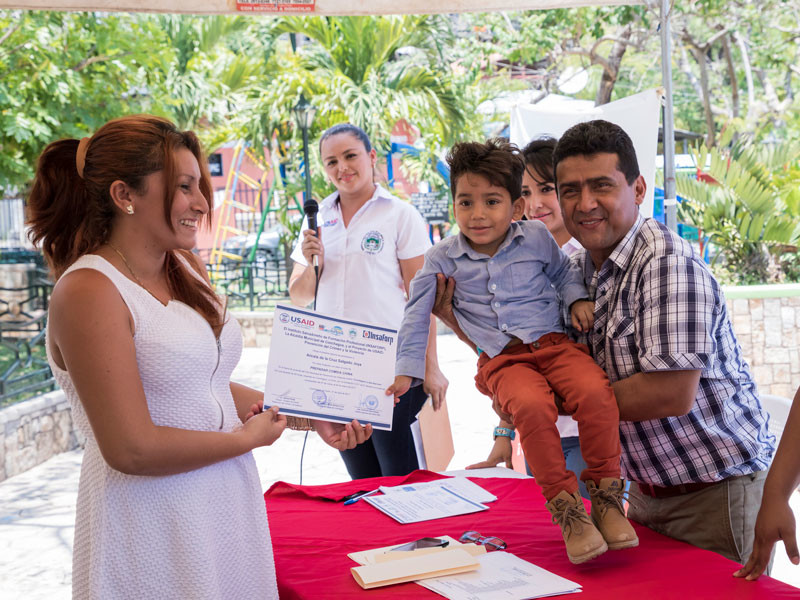
His optimism is backed up by numbers. Since their inception in 2015, the 16 Municipal Vocational Training Centers launched with support of the project have graduated 92 percent of those enrolled.
While Mendoza studies air conditioning repair, his peers across the country are getting certified in how to prepare international cuisine, guide tours, repair cell phones, install household electrical wiring and fix outboard motors for boats in the fishing and tourism industries. By providing skills and jobs, the project offers positive alternative for young people living in areas where, absent these opportunities, joining a gang may seem like a viable choice for economic security.
In addition to FORMATE centers, the project partnered with Microsoft to launch nine Microsoft Imagine Academies where youth gain in-demand technical skills and earn Microsoft certifications valued by potential employers. Nearly 1,450 total youth have already graduated with certifications, including Jorge Fuentes, a 24-year-old university student.
Fuentes says that the program does much more than just add a valuable accomplishment to resumes.
“In a place like Cojutepeque, which is categorized as one of the most violent municipalities, these types of opportunities give us a different perspective and make us realize there are a lot of opportunities for us,” he says. “It’s not just a course, it’s something valuable that also helps make friendships and allows us to meet people from different fields and broaden our thinking.”
When youth graduate from a FORMATE or Microsoft center, city-run Municipal Employment Unit facilitators, trained through the project, are ready to spring into action. They help graduates write resumes, meet company representatives and prepare for interviews. To date, more than 1,000 youth across the country have secured jobs through the units.
Community-led violence prevention
As the Crime and Violence Prevention Project moves into its final year, it’s working to ensure the continuation of its initiatives through partnerships with municipal governments, civil society groups and nonprofit organizations. It is also looking for unique approaches to violence prevention and creating opportunities for at-risk youth.
“Currently, the project is centering its attention on promoting innovative models for crime and violence prevention, from family counseling to tertiary violence prevention with a wide variety of social organizations and entities,” says Karen Duarte, Coordinator of the project’s innovative grants component.
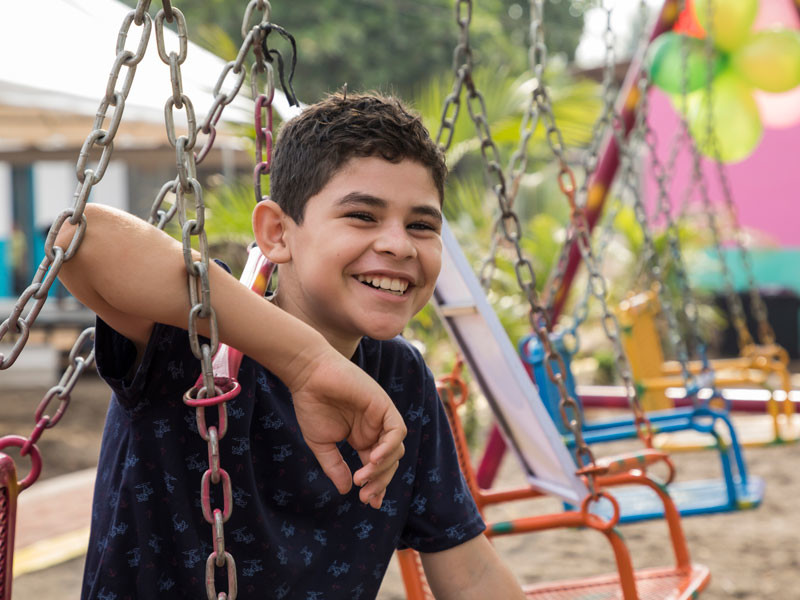
Through partnerships and grants, the project is supporting initiatives like SoyAutor (“I’m an Author”), giving at-risk youth an opportunity to tell their own stories through writing, and Factoría Ciudadana (“Citizen Factory”), which supports rehabilitation and social reintegration for youth who have been in trouble with the law, struggled with substance abuse, or been recently deported from the United States.
With recreation, workforce training and social opportunities for youth, the revival of public spaces and new tools for municipalities and law enforcement, municipalities like Cojutepeque are becoming more resilient in a country that still has one of the highest homicide rates in the world.
For Alexis, the project’s family counseling has helped him begin dreaming big: He hopes to become a doctor or a pilot someday. Alexis says he’d encourage his peers to look for similar opportunities to make positive change in their lives and in their communities.
“Just how it made me change, it can change so many more people,” he says. “So don’t turn away from opportunities like this, because it’s a really good thing.”
With reporting from El Salvador by Marta Maldonado and Amanda Smallwood and editing by Gerson Lara and Evelyn Rupert.


